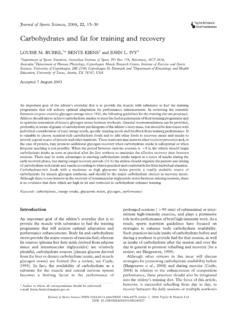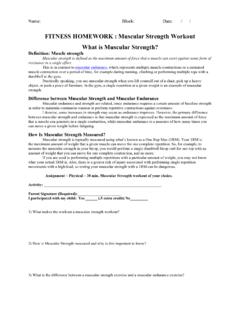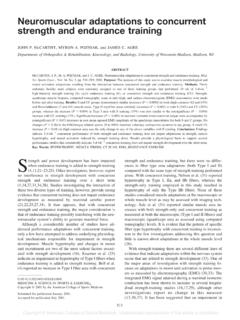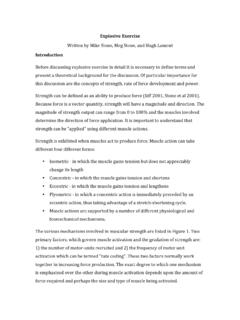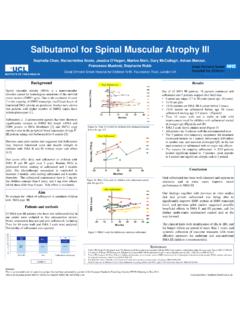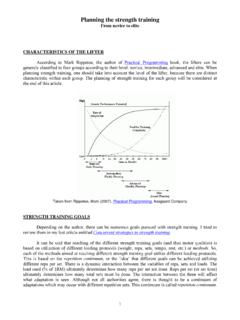Transcription of Progression Models in Resistance Training for …
1 SPECIAL COMMUNICATIONS. Progression Models in Resistance Training for Healthy Adults POSITION STAND. This pronouncement was written for the American College of Sports Medicine by Nicholas A. Ratamess, ; Brent A. Alvar, ; Tammy K. Evetoch, , FACSM; Terry J. Housh, , FACSM (Chair); W. Ben Kibler, , FACSM; William J. Kraemer, , FACSM; and N. Travis Triplett, SUMMARY with prior ones, recommendations should be applied in context and should be contingent upon an individual's target goals, physical capacity, and Training In order to stimulate further adaptation toward specific Training goals, status. Key Words: strength, power, local muscular endurance, fitness, progressive Resistance Training (RT) protocols are necessary. The optimal functional abilities, hypertrophy, health, performance characteristics of strength-specific programs include the use of concentric (CON), eccentric (ECC), and isometric muscle actions and the performance of bilateral and unilateral single- and multiple-joint exercises.
2 In addition, it INTRODUCTION. is recommended that strength programs sequence exercises to optimize the preservation of exercise intensity (large before small muscle group The current document replaces the American College exercises, multiple-joint exercises before single-joint exercises, and of Sports Medicine (ACSM) 2002 Position Stand entitled higher-intensity before lower-intensity exercises). For novice (untrained BProgression Models in Resistance Training for Healthy individuals with no RT experience or who have not trained for several Adults[ (8). The 2002 ACSM Position Stand extended the years) Training , it is recommended that loads correspond to a repetition range of an 8 12 repetition maximum (RM). For intermediate (individuals Resistance Training (RT) guidelines initially established by with approximately 6 months of consistent RT experience) to advanced the ACSM in the position stand entitled BThe Recommen- (individuals with years of RT experience) Training , it is recommended that ded Quantity and Quality of Exercise for Developing and individuals use a wider loading range from 1 to 12 RM in a periodized Maintaining Cardiorespiratory and Muscular Fitness, and fashion with eventual emphasis on heavy loading (1 6 RM) using 3- to Flexibility in Healthy Adults[ (7), which suggested the min- 5-min rest periods between sets performed at a moderate contraction velocity (1 2 s CON; 1 2 s ECC).]]
3 When Training at a specific RM load, it imal standard of one set of 8 12 repetitions for 8 10 exer- is recommended that 2 10% increase in load be applied when the cises, including one exercise for all major muscle groups, individual can perform the current workload for one to two repetitions and 10 15 repetitions for older and more frail persons. The over the desired number. The recommendation for Training frequency is 2002 Position Stand (8) provided a framework for superior 2 3 dIwkj1 for novice Training , 3 4 dIwkj1 for intermediate Training , and Training prescription guidelines relative to the need for pro- 4 5 dIwkj1 for advanced Training . Similar program designs are recom- mended for hypertrophy Training with respect to exercise selection and gression in healthy (without disease or orthopedic limitations). frequency. For loading, it is recommended that loads corresponding to novice, intermediate, and advanced trainees.
4 Specifically, 1 12 RM be used in periodized fashion with emphasis on the 6 12 RM these guidelines effectively distinguished numerous modifi- zone using 1- to 2-min rest periods between sets at a moderate velocity. cations to the original guidelines to accommodate individuals Higher volume, multiple-set programs are recommended for maximizing seeking muscular development beyond that of minimal hypertrophy. Progression in power Training entails two general loading strategies: 1) strength Training and 2) use of light loads (0 60% of 1 RM for general health and fitness. Since 2002, numerous studies have lower body exercises; 30 60% of 1 RM for upper body exercises) performed been published examining one or more RT variable(s) to sup- at a fast contraction velocity with 3 5 min of rest between sets for multiple port the progressive adaptation in muscular strength and per- sets per exercise (three to five sets).
5 It is also recommended that emphasis be formance. These studies have identified other mechanisms placed on multiple-joint exercises especially those involving the total body. of physiological adaptations and have served to bolster the For local muscular endurance Training , it is recommended that light to moderate loads (40 60% of 1 RM) be performed for high repetitions (915). scientific integrity of the RT knowledge base. As with all using short rest periods (G90 s). In the interpretation of this position stand as position stands, interpretation of these revised recommenda- tions should be applied in context and should be contin- gent upon an individual's goals, physical capacity, and 0195-9131/09/4103-0687/0 Training status. MEDICINE & SCIENCE IN SPORTS & EXERCISE! Progression in RT may be defined as Bthe act of moving Copyright " 2009 by the American College of Sports Medicine forward or advancing toward a specific goal over time until DOI: the target goal has been achieved,[ whereas maintenance 687.]
6 Copyright @ 2009 by the American College of Sports Medicine. Unauthorized reproduction of this article is prohibited. RT refers to programs designed to maintain the current level lengthened for strength and power Training ; and 5) Training of muscular fitness (8). Although it is impossible to improve volume (total work represented as the product of the total at the same rate over long-term periods ( , 96 months), number of repetitions performed and the Resistance ) may be the proper manipulation of program variables (choice of gradually increased ( , 5% [75]) (Table 2). Resistance , exercise selection and order, number of sets Specificity. All Training adaptations are Bspecific[ to and repetitions, frequency, and rest period length) can limit the stimulus applied. The specific physiological adapta- Training plateaus and increase the ability to achieve a higher tions to RT are determined by various factors, including level of muscular fitness.]
7 Trainable characteristics include 1) muscle actions involved (56), 2) speed of movement muscular strength, power, hypertrophy, and local muscular (39,44), 3) range of motion (145), 4) muscle groups trained endurance (LME). Variables such as speed and agility, (156), 5) energy systems involved (259), and 6) intensity balance, coordination, jumping ability, flexibility, and other and volume of Training (225). Although there is some car- measures of motor performance may be enhanced by RT. ryover of Training effects to other general fitness and per- RT, when incorporated into a comprehensive fitness pro- formance attributes, the most effective RT programs are gram, improves cardiovascular function (72), reduces the those that are designed to target-specific Training goals. risk factors associated with coronary heart disease (89,130) Variation. Variation, or periodization, entails the sys- and non insulin-dependent diabetes (184), prevents osteo- tematic process of altering one or more program variable(s).
8 Porosis (163), may reduce the risk of colon cancer (146), over time to allow for the Training stimulus to remain promotes weight loss and maintenance (61), improves dy- challenging and effective. Because the human body adapts namic stability and preserves functional capacity (61), and quickly to an RT program, at least some changes are needed fosters psychological well-being (62). in order for continual Progression to occur. It has been This position stand presents evidence-based guidelines shown that systematic variation of volume and intensity is using The National Heart, Lung, and Blood Institute (194) most effective for long-term Progression (254). Variation criteria shown in Table 1. Each recommendation is given a may take place in many forms and manifests by manip- grade of A, B, C, or D based on the quantity and quality of ulation of any one or a combination of the acute program evidence.
9 Variables. However, the two most commonly studied variables have been volume and intensity. The concept of periodization was developed based on the studies of gen- Progression PRINCIPLES. eral adaptation syndrome by Hans Selye (239) to optimize The foremost principles of RT Progression are progres- performance and recovery (74,100). In addition to sport- sive overload, specificity, and variation (157). Countless RT specific Training , periodized RT has been shown to be Models can be effective if these principles are incorporated effective for recreational (54) and rehabilitative (67) ob- and manipulated into the design. The magnitude of im- jectives and is supported through a meta-analytical inves- provement depends upon the individual's Training status and tigation to be superior to nonperiodized RT (223). genetic predisposition (8). Progressive overload is the grad- Classical periodization.
10 The classic (linear) model of ual increase of stress placed upon the body during exercise periodization is characterized by high initial Training Training . Among untrained or novice populations, physio- volume and low intensity, and as Training progresses, logical adaptations to an RT program may occur in a short volume decreases and intensity gradually increases. This period. Systematically increasing the demands placed upon traditional model of periodization is carried out to enhance the body is necessary for further improvement and may fundamental fitness variables through Training in a desig- be accomplished through altering one or more of the fol- nated succession to serve as an appropriate arrangement to lowing variables: 1) exercise intensity ( , absolute or elicit Bpeak[ performance of a distinct fitness variable ( , relative Resistance /load for a given exercise/movement) may strength, rate of force development [RFD], and/or peak SPECIAL COMMUNICATIONS.]
